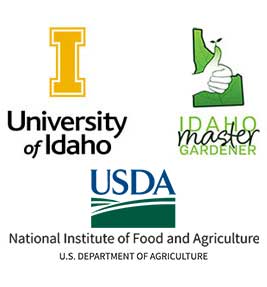Landscape & Garden Alerts
Swipe Left or Right to navigate Alerts
Eastern Idaho Pest Alert Summary June 20, 2025 | Volume 6, Issue 6
All Crops Eastern Idaho, Magic Valley
Eastern Idaho Pest Alert
Posted on: June 27, 2025 by Jemila Chellappa
Eastern Idaho Pest Alert June 20, 2025 | Volume 6, Issue 6
Coverage: Bannock, Bingham, Bonneville, Cassia, Fremont, Jefferson, Madison, Power, and Teton Counties
Prepared by: University of Idaho Extension, Bonneville County
Editor: Ron Patterson
Featured Pest Alerts
Raspberry Crown Borer (Pennisetia marginata)
- Pest Type: Clear-winged moth
- Damage: Larvae bore into crowns/roots, causing cane wilt, stunting, and reduced yield.
- IPM Tips:
- Remove infested canes in late summer/fall
- Eliminate nearby wild brambles
- Encourage plant vigor through irrigation
- Nighttime insecticide sprays can help
Pollinator Spotlight – Golden-Haired Flower Longhorn Beetle
- Species: Lepturobosca chrysocoma
- Role: Beneficial pollinator and wood decomposer
- Habitat: Flowers in meadows and forest edges
- Conservation Tips:
- Plant native wildflowers
- Avoid broad-spectrum insecticides
- Leave some deadwood for larval habitat
Fire Blight in Apples and Pears
- Symptoms: Blackened shoots, “burned” look after bloom
- Management:
- Prune infected shoots on dry days
- Disinfect tools between cuts
- Apply copper or antibiotics before/after rain or dew
- Note: Only spray if blossoms are still open
Codling Moth – 1st & 2nd Generation Spray Timing
- Crops at Risk: Apples, pears
- Egg Hatch Periods:
- June 9–30: Burley, Preston
- June 12–July 3: Idaho Falls, Blackfoot
- July 2: Driggs (2nd gen)
- Backyard & Commercial Tips:
- Use insecticides or oils at night for best control
- Follow region-specific timing tables
- Rotate products between generations
UPCOMING HOME GARDEN TIPS WEBINARS
View full schedule in the attached PDF
More Information Contact:
Lena Allen
Horticulture Secretary
University of Idaho
Bonneville County Extension
208.529.1390
1542 E 73rd S
Idaho Falls, ID 83404
» Pest_Alert_June_20_GoldenHaired_Flower_Longhorn_Beetle,_raspberry_crown_borer.pdf
Strawberry Root Weevil Pupa
All Crops Treasure Valley, Treasure Valley - Idaho, Eastern Idaho, Magic Valley, Northern Idaho, Treasure Valley Oregon
Strawberry Root Weevil
Posted on: June 12, 2025 by Jemila Chellappa
Strawberry Root Weevil Alert – Be on the Lookout!
Found Strawberry Root Weevil pupae in Treasure Valley: The pupa of the strawberry root weevil (Otiorhynchus ovatus) is a transitional life stage between the larva and adult, typically found in the soil near the root zone of host plants. Here are the key characteristics:
Strawberry Root Weevil – Pupal Stage Characteristics:
- Color: Initially creamy white; may turn light tan as it matures.
- Shape: Soft-bodied, oblong, and slightly curved. The body is segmented and resembles the general adult form.
- Size: About 5–7 mm in length, depending on species and development stage.
- Visibility of adult features: The legs, antennae, and developing snout (rostrum) of the adult are visible but folded close to the body.
- Habitat: Pupates in an earthen cell or cavity in the soil, usually close to the roots of infested strawberry or other host plants.
- Duration: The Pupal stage generally lasts 2–3 weeks in spring (April–June), depending on temperature and soil conditions.
- Mobility: Pupae are non-feeding and immobile.
Since pupae are hidden in the soil, they are rarely observed unless the soil is carefully excavated near the crown and roots of the plant. Refer to the attached file for a visual reference of the Strawberry Root Weevil Pupa
Strawberry root weevils (Otiorhynchus spp.) are common pests in strawberry fields across the Pacific Northwest. While adult weevils cause minor notching on leaves, the real damage comes from their larvae feeding on roots through winter and spring, leading to stunted growth, reduced yields, or even plant death in severe cases.
What to Watch For:
- Notched leaves from adult feeding (visible in early summer)
- Wilting or stunted plants from root damage
- Adults hide under plant debris during the day or emerge at night
Now is the time to inspect your strawberry fields. Check for notched leaves, look under plant debris, or monitor at night for adult activity. Early detection is key to preventing egg-laying and larval root damage.
If you notice signs, consider control options including biological (entomopathogenic nematodes), cultural (soil cultivation), or chemical treatments applied at night for best results. More management information here https://pnwhandbooks.org/insect/small-fruit/strawberry/strawberry-root-weevil
Stay alert and protect your berries!
» https://pnwhandbooks.org/insect/small-fruit/strawberry/strawberry-root-weevil
Eastern Idaho Pest Alert June 6, 2025 | Vol. 6, Issue 4
All Crops Eastern Idaho
Pest Alerts from Bonneville County – Eastern Idaho
Posted on: June 10, 2025 by Jemila Chellappa
Eastern Idaho Pest Alert June 6, 2025 | Vol. 6, Issue 4
Coverage Areas: Bannock, Bingham, Bonneville, Cassia, Fremont, Jefferson, Madison, and Teton Counties
CURRENT PEST AND DISEASE ISSUES
Fire Blight Alert
Fire blight risk levels are Exceptional to Extreme across most of Eastern Idaho through mid-June.
High-risk management strategies:
- Prune infected twigs and branches on dry days.
- Disinfect tools between each cut using alcohol, bleach solution, or disinfectant wipes.
- Apply antibiotics within 24 hours of a wetting event (rain or heavy dew) when blossoms are open.
- Biological control products (e.g., Blossom Protect, Double Nickel) are recommended for resistance management and organic systems.
Codling Moth Management
Egg hatch timing is highly variable due to unusual weather patterns this spring. Spray timing depends on prior fruit damage and production system.
Conventional Orchards:
- High damage history: Apply 2 sprays per generation (start with oil or insecticide).
- Low damage history: Fewer sprays needed, often just 1 per generation.
Organic Orchards:
- High damage history: 3 sprays per generation, spaced 7–10 days apart.
- Low damage history: 2 sprays per generation.
Backyard Trees:
- Treatment options include conventional (e.g., Triazicide, Sevin) and organic (e.g., Cyd-X, Neem oil, Spinosad) products. See page 7 for efficacy and timing.
Leafhoppers
- Leafhoppers feed on plant sap, causing stippling and potential fruit damage.
- Regular scouting is advised for sensitive crops like apples, pears, and grapes.
- IPM strategies include monitoring populations and protecting beneficial insects.
FRUIT PRODUCTION NOTES
Alternate Bearing in Apples
Many apple varieties alternate between heavy and light production years.
- In heavy crop years, thin fruits to reduce strain and encourage consistent yields next season.
- Thinning also improves fruit size and reduces limb breakage.
PESTICIDE AND BIOLOGICAL OPTIONS FOR FIRE BLIGHT
Refer to the full table on page 5 for:
- Antibiotic options (e.g., Oxytetracycline, Kasugamycin)
- Biological products (e.g., Serenade, BlightBan, Regalia)
- Copper-based sprays for pre-bloom or dormant application
UPCOMING HOME GARDEN TIPS WEBINARS - Check the PDF attached
View full schedule in the attached PDF or join online at:
Growing Degree Days Calculator
All Crops Treasure Valley, Treasure Valley - Idaho, Eastern Idaho, Magic Valley, Northern Idaho
Posted on: June 7, 2025 by Jemila Chellappa
New Feature Alert: Celebrate World Pest Awareness Day with PNW Pest Alert!
In honor of World Pest Awareness Day (June 6), we’re thrilled to announce a powerful new tool now available on www.pnw.pestalert.net
We’re excited to launch a brand-new tool on www.pestalert.net
Our Growing Degree Day (GDD) Calculator is now LIVE – designed to help you track pest development stages and make informed management decisions tailored to your location and crops. Check it out now: https://pnwpestalert.net/gdd/
Pest Alert – Codling Moth Activity Increasing in Apples
Apple Treasure Valley, Treasure Valley - Idaho
Codling Moth
Posted on: June 3, 2025 by Jemila Chellappa
Treasure Valley (Canyon County, Idaho)
June 2025
Moth captures confirmed from pheromone trap at local orchard (7 moths/trap/week)
Codling moth (Cydia pomonella) adult flight is active in the Treasure Valley region, with degree day (GDD) accumulations reaching ~680 (Base 50°F) as of June 2, 2025. Trap monitoring has confirmed moderate to high pressure, with 7 moths captured per trap this week.
- Track daily GDDs to prepare for second-generation sprays (expected at 1000–1100 GDD).
- Continue weekly trap monitoring to refine timing.
This timing coincides with peak first-generation egg hatch. Immediate action is advised to prevent worm damage to apples.
- Egg hatch typically begins at 250 GDD
- Peak egg hatch occurs between 650–750 GDD
- Now, in the critical larval emergence window
Recommended IPM Management Actions: Spray Immediately to Control Larvae
Apply a larvicide now to target newly hatched larvae. Follow label instructions and re-treatment intervals. Reapply if moth captures remain above the threshold.
Cultural & Mechanical Controls
- Thin fruit clusters to reduce entry points (leave one fruit per cluster, space ~6" apart).
- Remove and destroy infested or fallen fruit weekly.
- Bag fruit at quarter-size after spraying (brown paper bags or nylon footies with kaolin clay pre-soak).
- Keep trap records: If weekly trap catch exceeds 5–10 moths per trap, additional sprays may be needed.
Resistance Management
- Rotate modes of action (IRAC group) each generation to avoid resistance.
- Limit broad-spectrum insecticides that can flare up mites and reduce beneficial insects.
There are different management options to consider when controlling this pest.There are different management options to consider when controlling this pest.
https://pnwhandbooks.org/insect/tree-fruit/apple/apple-codling-moth
Option A: Starting at 200 DD, apply a mixture of water and horticultural oil at 1% concentration to smother egg infestation. Follow with the first application of insecticide at 350 DD. Reapply insecticides based on the protection interval stated on the label.
Option B: Starting at 220-250 DD, apply insecticides that target newly hatched larvae. Reapply insecticides based on the protection interval stated on the label.
The reference publication links to view insecticide options for commercial or residential sites.
This pest needs prevention all season long for clean fruit.
https://digitalcommons.usu.edu/cgi/viewcontent.cgi?article=1879&context=extension_curall
https://extension.colostate.edu/topic-areas/insects/codling-moth-control-in-home-plantings-5-613/
To report pest activity in your area: https://pnwpestalert.net/submitalert/
Summer 2025 Heat Wave Forecast: Be Prepared for Heat Stress in the Field!
All Crops Treasure Valley, Treasure Valley - Idaho, Eastern Idaho, Magic Valley, Northern Idaho
Heat Wave Forecast
Posted on: June 2, 2025 by Jemila Chellappa
"Protect Yourself and Your Crew from Extreme Heat: Gear up and Stay Hydrated"
According to NOAA's Climate Prediction Center the 2025 summer forecast calls for 'overwhelmingly above normal' heat starting in June link: Please take a moment to familiarize yourself with the symptoms of heat related illnesses and what actions to take.
Environmental Health and Safety links:
Managing-heat-stress-with-faqs
CDC links:
HeatRisk | Tracking | NCEH | CDC
About Heat and Your Health | Heat Health | CDC
Heat-related Illnesses | Heat | CDC
Remember to drink plenty of fluids, wear appropriate clothing, sunscreen, and pace yourselves.
More Information: Beth Brune
Operations Manager
University of Idaho | Kimberly R&E Center, Kimberly, ID 83341
Email: bbrune@uidaho.edu
Eastern Idaho Pest Alert MAY 30, 2025 VOL. 6 ISS. 3
All Crops Eastern Idaho, Magic Valley
Pest Alerts from Bonneville County – Eastern Idaho
Posted on: June 1, 2025 by Jemila Chellappa
Coverage Areas: Bannock, Bingham, Bonneville, Cassia, Fremont, Jefferson, Madison, and Teton Counties
CURRENT PEST AND DISEASE ISSUES
Fire Blight Alert
- Fire blight risk levels are Exceptional to Extreme across most regions in Eastern Idaho through mid-June.
- High-risk management includes:
- Pruning out infections on dry days.
- Disinfecting tools between cuts.
- Applying antibiotics within 24 hours of a wetting event when blossoms are open.
- Consider biological control products for resistance management.
- A full table of risk periods by location is provided, with tailored spray guidance.
Codling Moth Management
- Egg hatch timing is highly variable due to weather.
- Management recommendations differ based on past fruit damage levels and whether growers use conventional or organic approaches.
- Conventional:
- Two sprays per generation recommended for high damage history.
- Fewer sprays for low-damage history, starting with oil or insecticide.
- Organic:
- Three sprays spaced 7–10 days apart for high-damage history.
- Two sprays per generation for low-damage history.
- Backyard tree treatment options include both conventional and organic products.
Leafhoppers
- Feeding causes stippling on leaf surfaces and can damage fruit.
- Monitoring and management are advised, especially for sensitive crops.
FRUIT PRODUCTION NOTES
Alternate Bearing in Apples
- Many apple varieties exhibit alternate bearing with heavy crops every other year.
- Best management is to thin fruits in heavy years to balance future yields.
PESTICIDE AND BIOLOGICAL OPTIONS FOR FIRE BLIGHT
UPCOMING HOME GARDEN TIPS WEBINARS: Check the PDF attached
Let’s work together to protect both our crops and our ecosystem. Reach out to your local Extension office for help with insect ID and integrated pest management (IPM) strategies tailored for your area https://www.uidaho.edu/extension/directory/counties
More Information, Contact:
Lena Allen
Horticulture Secretary
University of Idaho
Bonneville County Extension
208.529.1390
» Pest_Alert_May_30_2025_alternate_bearing_fruit,_leafhopper.pdf



